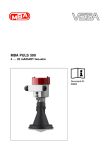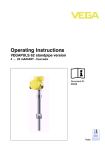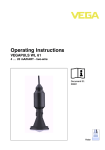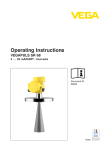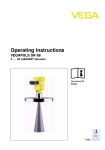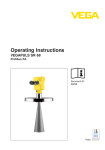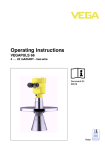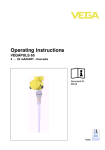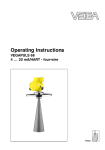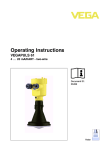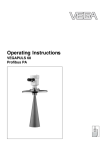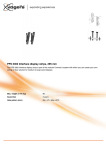Download Operating Instructions - MBA PULS 400 - 4 ? 20 mA/HART two-wire
Transcript
MBA PULS 400 4 … 20 mA/HART two-wire Document ID: 36823 Contents Contents 1 About this document 1.1 1.2 1.3 2 . . . . . . . . . . . . . . . . . . . . . . . . . . . . . . . . .. .. .. .. .. .. .. .. 5 5 5 5 6 6 6 6 . . . . . . . . . . . . . . . . . . . . . . . . . . . . . . . . .. .. .. .. 7 8 8 9 General instructions . . . . . . . . . . . . . . . . . Mounting preparations - Horn antenna . . . . Mounting preparations - Parabolic antenna. Mounting instructions . . . . . . . . . . . . . . . . . . . . . . . . . . . . . . . . . . . . . . . . .. .. .. .. 10 10 11 12 . . . . . . . . . . . . . . . . . . . . . . . . . . . . . . . . . . . . .. .. .. .. .. .. 25 26 27 27 29 29 Configuration . . . . . . . . . . . . . . . . . Principle of operation . . . . . . . . . . . Packaging, transport and storage . . Accessories and replacement parts . . . . . . . . . . . . . Preparing the connection . . . . . . . . . . . . . Connection. . . . . . . . . . . . . . . . . . . . . . . . Wiring plan, single chamber housing . . . . . Wiring plan, double chamber housing . . . . Wiring plan double chamber housing Ex d . Switch on phase. . . . . . . . . . . . . . . . . . . . Insert indicating and adjustment module. Adjustment system . . . . . . . . . . . . . . . . Parameter adjustment. . . . . . . . . . . . . . Saving the parameter adjustment data . . . . . . . . . . . . . . . . . . . . . . . . . . . . . . . . . . .. .. .. .. 31 32 33 41 . . . . . . . . . . . . . . . . . . . . . . . . . . . . . . . . .. .. .. .. 42 42 44 44 Diagnosis, fault rectification and service Maintenance . . . . . . . . . . . . . . . . . . Error messages according to NE 107 Rectify malfunctions . . . . . . . . . . . . . How to proceed in case of repair. . . . . . . . . . . . MBA PULS 400 • 4 … 20 mA/HART two-wire 36823-EN-091125 7.1 7.2 7.3 7.4 2 . . . . . . . . Set up with the indicating and adjustment module 6.1 6.2 6.3 6.4 7 . . . . . . . . Connecting to power supply 5.1 5.2 5.3 5.4 5.5 5.6 6 . . . . . . . . Mounting 4.1 4.2 4.3 4.4 5 . . . . . . . . Authorised personnel . . . . . . . . . . . . . . Appropriate use . . . . . . . . . . . . . . . . . . Warning about misuse . . . . . . . . . . . . . General safety instructions . . . . . . . . . . CE conformity . . . . . . . . . . . . . . . . . . . Fulfillment of NAMUR recommendations Radio approval for Europe . . . . . . . . . . Radio approval for USA/Canada . . . . . . Product description 3.1 3.2 3.3 3.4 4 4 4 4 For your safety 2.1 2.2 2.3 2.4 2.5 2.6 2.7 2.8 3 Function. . . . . . . . . . . . . . . . . . . . . . . . . . . . . . . . . . Target group . . . . . . . . . . . . . . . . . . . . . . . . . . . . . . Symbolism used. . . . . . . . . . . . . . . . . . . . . . . . . . . . Contents 8 Dismounting 8.1 8.2 9 Dismounting steps . . . . . . . . . . . . . . . . . . . . . . . . . . Disposal . . . . . . . . . . . . . . . . . . . . . . . . . . . . . . . . . 45 45 Supplement 9.1 9.2 Technical data . . . . . . . . . . . . . . . . . . . . . . . . . . . . . Dimensions . . . . . . . . . . . . . . . . . . . . . . . . . . . . . . . 46 54 36823-EN-091125 Safety instructions for Ex areas Please note the Ex-specific safety information for installation and operation in Ex areas. These safety instructions are part of the operating instructions manual and come with the Ex-approved instruments. MBA PULS 400 • 4 … 20 mA/HART two-wire 3 1 About this document 1 About this document 1.1 Function This operating instructions manual provides all the information you need for mounting, connection and setup as well as important instructions for maintenance and fault rectification. Please read this information before putting the instrument into operation and keep this manual accessible in the immediate vicinity of the device. 1.2 Target group This operating instructions manual is directed to trained qualified personnel. The contents of this manual should be made available to these personnel and put into practice by them. 1.3 Symbolism used Information, tip, note This symbol indicates helpful additional information. Caution: If this warning is ignored, faults or malfunctions can result. Warning: If this warning is ignored, injury to persons and/or serious damage to the instrument can result. Danger: If this warning is ignored, serious injury to persons and/or destruction of the instrument can result. Ex applications This symbol indicates special instructions for Ex applications. l à 1 List The dot set in front indicates a list with no implied sequence. Action This arrow indicates a single action. Sequence Numbers set in front indicate successive steps in a procedure. 36823-EN-091125 4 MBA PULS 400 • 4 … 20 mA/HART two-wire 2 For your safety 2 For your safety 2.1 Authorised personnel All operations described in this operating instructions manual must be carried out only by trained specialist personnel authorised by the plant operator. During work on and with the device the required personal protective equipment must always be worn. 2.2 Appropriate use MBA PULS 400 is a sensor for continuous level measurement. You can find detailed information on the application range in chapter "Product description". Operational reliability is ensured only if the instrument is properly used according to the specifications in the operating instructions manual as well as possible supplementary instructions. 2.3 Warning about misuse Inappropriate or incorrect use of the instrument can give rise to application-specific hazards, e.g. vessel overfill or damage to system components through incorrect mounting or adjustment. 2.4 General safety instructions This is a state-of-the-art instrument that fulfils the prevailing regulations and guidelines. The instrument must only be operated in a technically flawless and reliable condition. The operator is responsible for the trouble-free operation of the instrument. During the entire duration of use, the user is obliged to determine the compliance of the required occupational safety measures with the current valid rules and regulations and also take note of new regulations. The safety instructions in this operating instructions manual, the national installation standards as well as the valid safety regulations and accident prevention rules must be observed by the user. 36823-EN-091125 For safety and warranty reasons, any invasive work on the device beyond that described in the operating instructions manual may be carried out only by personnel authorised by the manufacturer. Arbitrary conversions or modifications are explicitly forbidden. The safety approval markings and safety tips on the device must be also observed. MBA PULS 400 • 4 … 20 mA/HART two-wire 5 2 For your safety Depending on the instrument version, the emitting frequencies are in the C or K band range. The low emitting frequencies are far below the internationally approved limit values. When used correctly, no health impairment is expected. 2.5 CE conformity The device fulfills the legal requirements of the applicable EC guidelines. By attaching the CE mark, we provide confirmation of successful testing. 2.6 Fulfillment of NAMUR recommendations The device fulfills the requirements of the applicable NAMUR recommendations. 2.7 Radio approval for Europe The instrument is approved according to EN 302372-2:2006-08 for use in closed vessels. 2.8 Radio approval for USA/Canada The radar sensor MBA PULS 400 with all antenna versions is FCC/IC approved. Modifications not expressly approved by the manufacturer will lead to expiry of the operating licence according to FCC/IC. The instrument is in conformity with part 15 of the FCC directives and fulfills the RSS-210 regulations. Note the corresponding regulations for operation: l l The instrument must not cause any interfering emissions The device must be insensitive to interfering immissions, including those that may cause undesirable operating conditions. The instrument is designed for operation with an antenna according to chapter "Dimensions" of this operating instructions manual, with a max. amplification of 33 dB. The instrument must not be operated with antennas not listed therein or those having an amplification of more than 33 dB. The required antenna impedance is 50 Ω. 36823-EN-091125 6 MBA PULS 400 • 4 … 20 mA/HART two-wire 3 Product description 3 Product description 3.1 Configuration Type label The type label contains the most important data for identification and use of the instrument: 1 2 3 4 5 6 7 8 10 9 Fig. 1: Structure of the type label (example) 1 2 3 4 5 6 7 8 Scope of delivery Instrument type Product code Approvals Process temperature, process pressure Electronics Protection rating Order number Serial number of the instrument The scope of delivery encompasses: Radar sensor Documentation - this operating instructions manual - Operating instructions manual "Indicating and adjustment module" (optional) - Supplementary instructions manual "Heating for indicating and adjustment module" (optional) - Supplementary instructions manual "Plug connector for continuously measuring sensors" (optional) - Ex-specific "Safety instructions" (with Ex-versions) - if necessary, further certificates 36823-EN-091125 l l MBA PULS 400 • 4 … 20 mA/HART two-wire 7 3 Product description 3.2 Principle of operation Application area A version of MBA PULS 400 is available for each area of application. The version with horn antenna is particularly suitable for small silos and vessels for measurement of virtually all bulk solids. The version with parabolic antenna is particularly suitable for large silos and vessels with up to 75 m (246 ft) measuring distance and for measurement of bulk solids with low εr value The instrument is also suitable for applications in liquids. Functional principle The antenna of the radar sensor emits short radar pulses with a duration of approx. 1 ns. These pulses are reflected by the product and received by the antenna as echoes. The running time of the radar pulses from emission to reception is proportional to the distance and hence to the level. The determined level is converted into an appropriate output signal and outputted as measured value. 3.3 Packaging, transport and storage Packaging Your instrument was protected by packaging during transport. Its capacity to handle normal loads during transport is assured by a test according to DIN EN 24180. The packaging of standard instruments consists of environmentfriendly, recyclable cardboard. For special versions, PE foam or PE foil is also used. Dispose of the packaging material via specialised recycling companies. Transport Transport must be carried out under consideration of the notes on the transport packaging. Nonobservance of these instructions can cause damage to the device. Transport inspection The delivery must be checked for completeness and possible transit damage immediately at receipt. Ascertained transit damage or concealed defects must be reported. Storage Up to the time of installation, the packages must be left closed and stored according to the orientation and storage markings on the outside. Unless otherwise indicated, the packages must be stored only under the following conditions: 8 Not in the open Dry and dust free Not exposed to corrosive media Protected against solar radiation Avoiding mechanical shock and vibration l Storage and transport temperature see chapter "Supplement Technical data - Ambient conditions" MBA PULS 400 • 4 … 20 mA/HART two-wire 36823-EN-091125 Storage and transport temperature l l l l l 3 Product description l Relative humidity 20 … 85 % 3.4 Accessories and replacement parts Indicating and adjustment module The indicating and adjustment module is used for measured value indication, adjustment and diagnosis. It can be inserted into the sensor and removed at any time. 36823-EN-091125 You find further information in the operating instructions "Indicating and adjustment module" (Document-ID 36825). MBA PULS 400 • 4 … 20 mA/HART two-wire 9 4 Mounting 4 Mounting 4.1 General instructions Screwing in With instruments with threaded process fitting, suitable tools must be applied for tightening the hexagon. Warning: The housing must not be used to screw the instrument in! Applying tightening force can damage internal parts of the housing. Moisture Use the recommended cables (see chapter "Connecting to power supply") and tighten the cable gland. You can give your instrument additional protection against moisture penetration by leading the connection cable downward in front of the cable entry. Rain and condensation water can thus drain off. This applies mainly to outdoor mounting as well as installation in areas where high humidity is expected (e.g. through cleaning processes) or on cooled or heated vessels. Suitability for the process conditions Make sure that all parts of the instrument exposed to the process, in particular the antenna, seal and process fitting, are suitable for the existing process conditions. These include above all the process pressure, process temperature as well as the chemical properties of the medium. You can find the specifications in chapter "Technical data" or on the type label. 4.2 Mounting preparations - Horn antenna The instrument is also available in versions where the antenna has a bigger diameter than the process fitting (thread, flange). The antenna must therefore be disconnected from the process fitting before mounting. Proceed as follows: 1 Loosen the hexagon screws (3) on the antenna socket with an Allen wrench (size 3) 2 Remove the antenna (4) Note: The plastic conemust not be pulled out of the antenna socket. Insert the antenna from below into the vessel socket and secure it against falling off 4 Retighten the antenna with hexagon screws to the antenna socket; torque max. 10 Nm (7.5 lbf ft) MBA PULS 400 • 4 … 20 mA/HART two-wire 36823-EN-091125 10 3 4 Mounting Note: The radar sensor with rinsing air connection or antenna extension is provided with a notch on the antenna socket. This notch must correspond to the marking on the hexagon of the process fitting (the marking specifies the position of the polarisation level of the radar signal). 1 2 3 4 Fig. 2: Dismounting of the horn antenna 1 2 3 4 Marking of the polarisation plane Notch at the antenna socket Hexagon screws on the antenna socket Antenna 4.3 Mounting preparations - Parabolic antenna 36823-EN-091125 The instrument is also available in versions where the antenna has a diameter larger than the process fitting (thread, flange). With such versions the antenna must be disconnected from the process fitting before mounting. Proceed as follows: 1 Clamp MBA PULS 400 with the flange, e.g. in a bench vice 2 Hold the connection piece (3) with a wrench (width across flats 22) on the flattenings 3 Loosen counter nut (2) completely with a wrench (width across flats 36) in the antenna direction 4 Loosen compression nut (1) completely with a wrench (width across flats 41) in the antenna direction 5 Remove the parabolic antenna (4) axially 6 Mount sensor flange to the adapter flange and clamp it 7 Check, if the O-ring seal is available on the connection piece and if it is not damaged. MBA PULS 400 • 4 … 20 mA/HART two-wire 11 4 Mounting Note: A damaged O-ring seal must be replaced: FKM (Viton) article no. 2.28248, FFKM (Kalrez 6375) article no. 2.27351 8 Remount the parabolic antenna (4) 9 Fasten compression nut (1) with a wrench (width across flats 41), torque max. 50 Nm 10 Fasten counter nut (2) with a wrench (width across flats 36), torque max. 40 Nm Note: Take note for the version with rinsing air connection that the holes in the antenna and in the process fitting correspond. This ensures a sufficient air flow (the air is led through the holes to the feed system. A rinsing of the parabolic antenna in total is not intended). 1 2 3 4 Fig. 3: Dismounting, parabolic antenna 1 2 3 4 Compression nut Locknut Connection piece Parabolic antenna 4.4 Mounting instructions The illustrations with the following mounting instructions show a radar sensor with horn antenna. The mounting instructions apply analogously also to the version with parabolic antenna. Polarisation plane The emitted radar impulses of the radar sensor are electromagnetic waves. The polarisation level is the direction of the electrical wave component. By turning the instrument in the connection flange or mounting boss, the polarisation can be used to reduce the effects of false echoes. The position of the polarisation plane is marked on the process fitting of the instrument. 12 MBA PULS 400 • 4 … 20 mA/HART two-wire 36823-EN-091125 Horn and parabolic antenna 4 Mounting 11 Fig. 4: Position of the polarisation level 1 Mounting position Marking hole Mount the sensor at least 200 mm (7.874 in) away from the vessel wall. 1 > 200 mm (7.87") Fig. 5: Mounting of the radar sensor on round vessel tops If you cannot keep this distance you should carry out a false echo storage before setup. This applies mainly if buildup on the vessel wall is expected. In this case, we recommend repeating a false echo storage later with existing buildup. Mounting should not be too close to the inflowing material as the microwave signal will be interferred. The optimum mounting position is on the opposite of the filling. To avoid strong pollution, the distance to the filter or dust extraction must be as big as possible. 36823-EN-091125 Inflowing medium MBA PULS 400 • 4 … 20 mA/HART two-wire 13 4 Mounting Fig. 6: Mounting of the radar sensor with inflowing medium The socket piece should be dimensioned in such a way that the antenna end protrudes slightly out of the socket. ca. 10 mm Socket 14 MBA PULS 400 • 4 … 20 mA/HART two-wire 36823-EN-091125 Fig. 7: Recommended socket mounting 4 Mounting When using a swivelling holder, keep in mind that the distance between antenna and socket gets smaller as the inclination of the sensor increases. Additional false reflections may be generated which can influence the measuring result at close range. Fig. 8: Distance between antenna and socket h max. If the medium has good reflective properties, MBA PULS 400 can also be mounted on a longer socket piece. Recommended values for socket heights are specified in the following illustration. You must carry out a false echo storage afterwards. d 36823-EN-091125 Fig. 9: Deviating socket dimensions Socket diameter d Socket length h 40 mm 100 mm 50 mm 150 mm 80 mm 250 mm MBA PULS 400 • 4 … 20 mA/HART two-wire 15 4 Mounting Socket diameter d Socket length h 100 mm 500 mm 150 mm 800 mm Socket diameter d 1½" Socket length h 3.9 in 2" 5.9 in 3" 9.8 in 4" 19.7 in 6" 31.5 in Tip: The instrument is also optionally available with an antenna extension. The antenna length can be selected (either ex works or later) to allow the antenna to protrude slightly out of the end of the mounting socket. Due to the antenna extension however, disturbing reflections are generated in the close-up range. This can lead to an increase in the required minimum distance, especially with poorly reflecting media such as plastic powder. In practice, a cleanly constructed mounting socket, if necessary with rounded edges, introduces fewer disturbing influences than an antenna extension. Orientation To measure as much of the vessel volume as possible, the sensor should be aligned so that the measuring beam reaches the lowest level in the vessel. In a cylindrical silo with conical outlet, the easiest way is to mount the instrument in the center of the silo. 36823-EN-091125 16 MBA PULS 400 • 4 … 20 mA/HART two-wire 4 Mounting Fig. 10: Orientation 36823-EN-091125 If mounting in the center of the silo is not possible, the sensor can be directed to the vessel center by means of an optional swivelling holder. The following description gives an overview on the determination of the necessary angle of inclination. MBA PULS 400 • 4 … 20 mA/HART two-wire 17 4 Mounting d α a Fig. 11: Proposal for installation after orientation MBA PULS 400 The angle of inclination depends on the vessel dimensions. It can be easily checked with a suitable level or water leve on the sensor. The following chart specifies the distance "a" between installation position and vessel centre dependent on the measuring distance for inclination angles of 2° … 10°. 4° 6° 8° 10° 2 0.1 0.1 0.2 0.3 0.4 4 0.1 0.3 0.4 0.6 0.7 6 0.2 0.4 0.6 0.8 1.1 8 0.3 0.6 0.8 1.1 1.4 10 0.3 0.7 1.1 1.4 1.8 15 0.5 1.0 1.6 2.1 2.6 20 0.7 1.4 2.1 2.8 3.5 25 0.9 1.7 2.6 3.5 4.4 30 1.0 2.1 3.2 4.2 5.3 35 1.2 2.4 3.7 4.9 6.2 40 1.4 2.8 4.2 5.6 7.1 45 1.6 3.1 4.7 6.3 7.9 MBA PULS 400 • 4 … 20 mA/HART two-wire 36823-EN-091125 18 Distance d 2° (m) 4 Mounting Distance d 2° (m) 4° 6° 8° 10° 50 1.7 3.5 5.3 7 8.8 55 1.9 3.8 5.8 7.7 9.7 60 2.1 4.2 6.3 8.4 10.6 65 2.3 4.5 6.8 9.1 11.5 70 2.4 4.9 7.4 9.8 12.3 Example: In a vessel 20 m high, the installation position of the sensor is 1.4 m from the vessel centre. The necessary angle of inclination of 4° can be read out from this chart. Proceed as follows to adjust the angle of inclination with the swivelling holder: 1 Loosen terminal screw of the swivelling holder with a fork spanner SW 13 2 Direct the sensor, check angle of inclination Information: The max. angle of inclination of the swivelling holder is approx. 15° 3 Tighten the terminal screw, torque max. 20 Nm. Information: The hexagon screws must not be loosened. Vessel installations The mounting location of the radar sensor should be a place where no other equipment or fixtures cross the path of the microwave signals. Vessel installations, such as e.g. ladders, limit switches, heating spirals, struts, etc., can cause false echoes that can influence the useful echo. Make sure when planning your measuring site that the radar sensor has a "clear view" to the measured product. In case of existing vessel installations, a false echo storage should be carried out during setup. 36823-EN-091125 If large vessel installations such as struts or supports cause false echoes, these can be attenuated through supplementary measures. Small, inclined sheet metal baffles above the installations scatter the radar signals and prevent direct interfering reflections. MBA PULS 400 • 4 … 20 mA/HART two-wire 19 4 Mounting Fig. 12: Cover smooth profiles with deflectors Agitators If there are agitators in the vessel, a false signal suppression should be carried out with the agitators in motion. This ensures that the interfering reflections from the agitators are saved with the blades in different positions. Fig. 13: Agitators Material heaps Large material heaps are detected with several sensors, which can be mounted on e.g. traverse cranes. For this type of application, it is best to orient the sensor toward the solid surface. A mutual infuence of the sensors is not possible. 36823-EN-091125 20 MBA PULS 400 • 4 … 20 mA/HART two-wire 4 Mounting Fig. 14: Radar sensors on traverse crane Information: Keep in mind that for these applications, the sensors are designed for relatively slow level changes. When using MBA PULS 400 on a movable bracket, the max. measuring rate must be observed (see chapter "Technical data"). Mounting in the vessel insulation Instruments for a temperature range up to 250 °C or up to 450 °C have a distance piece between process fitting and electronics housing. Ths distance piece is used for thermal decoupling of the electronics against high process temperatures. 36823-EN-091125 Information: The distance piece must only be incorporaed up to max. 50 mm in the vessel installation. Only then, a reliable temperature decoupling is guaranteed. MBA PULS 400 • 4 … 20 mA/HART two-wire 21 4 Mounting max. 50 mm (1.97") 1 2 3 Fig. 15: Mounting of the instrument with insulated vessels. 1 2 3 Mounting in multiple chamber silo Electronics housing Distance piece Vessel insulation The silo walls of multiple chamber silos are often made of profile walls, such as e.g. profile sheeting, to ensure the required stability. If the radar sensor is mounted very close to a heavily structured vessel wall, considerable false reflections can be generated. Hence the sensor should be mounted at a large distance from the separating wall. The optimal mounting position is on the outer wall of the silo with the sensor directed towards the emptying aperture in the silo center. 22 MBA PULS 400 • 4 … 20 mA/HART two-wire 36823-EN-091125 Fig. 16: Installation of MBA PULS 400 in multiple chamber silos 4 Mounting Fig. 17: Orientation of MBA PULS 400 for emptying in the silo center Dust layers To avoid strong buildup and dust in the antenna system, the sensor should not be mounted directly at the dust extraction of the vessel. In case of extreme dust in the antenna system, MBA PULS 400 is available with purging air connection. The air is distributed via channels in the antenna system and keeps it virtually free of dust. 36823-EN-091125 Fig. 18: Purging air connection with horn antenna MBA PULS 400 • 4 … 20 mA/HART two-wire 23 4 Mounting Fig. 19: Purging air connection with parabolic antenna The practice has shown that a pressure of approx. 0.2 … 1 bar provides a sufficient air flow (see diagram in chapter "Technical data", "Purging air connection". 36823-EN-091125 24 MBA PULS 400 • 4 … 20 mA/HART two-wire 5 Connecting to power supply 5 Connecting to power supply 5.1 Preparing the connection Safety instructions Always keep in mind the following safety instructions: l l Power supply Connect only in the complete absence of line voltage If overvoltages are expected, install overvoltage arresters Power supply and current signal are carried on the same two-wire cable. The voltage supply range can differ depending on the instrument version. The data for power supply are specified in chapter "Technical data". Provide a reliable separation between the supply circuit and the mains circuits according to DIN VDE 0106 part 101. Keep in mind the following additional influences on the operating voltage: l l Connection cable Output voltage of the power supply unit can be lower under nominal load (with a sensor current of 20.5 mA or 22 mA in case of fault message) Influence of additional instruments in the circuit (see load values in chapter "Technical data") The instrument is connected with standard two-wire cable without screen. If electromagnetic interference is expected which is above the test values of EN 61326 for industrial areas, screened cable should be used. Use cable with round cross-section. A cable outer diameter of 5 … 9 mm (0.2 … 0.35 in) ensures the seal effect of the cable gland. If you are using cable with a different diameter or cross-section, exchange the seal or use a suitable cable gland. We generally recommend the use of screened cable for HART multidrop mode. 36823-EN-091125 Cable screening and grounding If screened cable is necessary, connect the cable screen on both ends to ground potential. In the sensor, the screen must be connected directly to the internal ground terminal. The ground terminal on the outside of the housing must be connected to the potential equalisation (low impedance). If potential equalisation currents are expected, the connection on the processing side must be made via a ceramic capacitor (e. g. 1 nF, 1500 V). The low frequency potential equalisation currents are thus suppressed, but the protective effect against high frequency interference signals remains. MBA PULS 400 • 4 … 20 mA/HART two-wire 25 5 Connecting to power supply 5.2 Connection Connection technology The connection of the voltage supply and the signal output is carried out via the spring-loaded terminals in the housing. The connection to the indicating and adjustment module or to the interface adapter is carried out via contact pins in the housing. Connection procedure Proceed as follows: 1 Unscrew the housing cover 2 If an indicating and adjustment module is installed, remove it by turning it slightly to the left. 3 Loosen compression nut of the cable entry 4 Remove approx. 10 cm (4 in) of the cable mantle, strip approx. 1 cm (0.4 in) of insulation from the ends of the individual wires 5 Insert the cable through the cable gland into the sensor Fig. 20: Connection steps 5 and 6 6 Insert the wire ends into the terminals according to the wiring plan 7 26 Check the hold of the wires in the terminals by lightly pulling on them MBA PULS 400 • 4 … 20 mA/HART two-wire 36823-EN-091125 Information: Solid cores as well as flexible cores with cable end sleeves are inserted directly into the terminal openings. In case of flexible cores without end sleeves, press the terminal head with a small screwdriver; the terminal opening is freed. When the screwdriver is released, the terminal closes again. 5 Connecting to power supply 8 Connect the screen to the internal ground terminal, connect the outer ground terminal with potential equalisation 9 Tighten the compression nut of the cable entry. The seal ring must completely encircle the cable 10 Screw the housing cover on The electrical connection is finished. Information: The terminal block is pluggable and can be removed from the electronics. For this purpose, lift the terminal block with a small screwdriver and pull it out. When inserting the terminal block again, you should hear it snap in. 5.3 Wiring plan, single chamber housing The following illustration applies to the non-Ex as well as to the Ex-ia version. Electronics and connection compartment 2 3 4...20mA (+)1 2(-) 5 6 7 8 4 1 Fig. 21: Electronics and connection compartment, single chamber housing 1 2 3 4 Voltage supply/Signal output For indicating and adjustment module or interface adapter For external indicating and adjustment unit Ground terminal for connection of the cable screen 5.4 Wiring plan, double chamber housing 36823-EN-091125 The following illustrations apply to the non-Ex as well as to the Ex-ia version. MBA PULS 400 • 4 … 20 mA/HART two-wire 27 5 Connecting to power supply Electronics compartment 2 4...20mA (+)1 2(-) 1 5 6 7 8 1 Fig. 22: Electronics compartment, double chamber housing 1 2 Internal connection to the connection compartment For indicating and adjustment module or interface adapter Connection compartment 2 4...20mA (+)1 2(-) 3 1 Fig. 23: Connection compartment, double chamber housing 1 2 3 Voltage supply/Signal output For indicating and adjustment module or interface adapter Ground terminal for connection of the cable screen 36823-EN-091125 28 MBA PULS 400 • 4 … 20 mA/HART two-wire 5 Connecting to power supply 5.5 Wiring plan double chamber housing Ex d Electronics compartment 2 4...20mA (+)1 2(-) 1 5 6 7 8 3 Fig. 24: Electronics compartment, double chamber housing 1 2 3 Internal connection to the connection compartment For indicating and adjustment module or interface adapter Internal connection to the plug connector for external indicating and adjustment unit (optional) Connection compartment 4...20mA (+)1 2(-) 2 1 Fig. 25: Connection compartment double chamber housing Ex d 1 2 Voltage supply/Signal output Ground terminal for connection of the cable screen 5.6 Switch on phase 36823-EN-091125 After connecting the instrument to power supply or after a voltage recurrence, the instrument carries out a self-check for approx. 30 seconds: l l l Internal check of the electronics Indication of the instrument type, the software version as well as the measurement loop name Output signal jumps to the adjusted error current until a plausible measured value is found MBA PULS 400 • 4 … 20 mA/HART two-wire 29 5 Connecting to power supply Then the corresponding current is outputted to the signal cable. The value corresponds to the actual level as well as the settings already carried out, e.g. factory setting. 36823-EN-091125 30 MBA PULS 400 • 4 … 20 mA/HART two-wire 6 Set up with the indicating and adjustment module 6 Set up with the indicating and adjustment module 6.1 Insert indicating and adjustment module Mount/Dismount indicating and adjustment module The indicating and adjustment module can be inserted into the sensor and removed again at any time. It is not necessary to interrupt the power supply. Proceed as follows: 1 Unscrew the housing cover 2 Place the indicating and adjustment module in the desired position on the electronics (you can choose any one of four different positions - each displaced by 90°) 3 Press the indicating and adjustment module onto the electronics and turn it to the right until it snaps in. 4 Screw housing cover with inspection window tightly back on Removal is carried out in reverse order. 36823-EN-091125 The indicating and adjustment module is powered by the sensor, an additional connection is not necessary. Fig. 26: Insert indicating and adjustment module MBA PULS 400 • 4 … 20 mA/HART two-wire 31 6 Set up with the indicating and adjustment module Note: If you intend to retrofit the instrument with an indicating and adjustment module for continuous measured value indication, a higher cover with an inspection glass is required. 6.2 Adjustment system 1 2 Fig. 27: Indicating and adjustment elements Key functions Adjustment system LC display Adjustment keys l [OK] key: - Move to the menu overview - Confirm selected menu - Edit parameter - Save value l [->] key: - Presentation change measured value - list entry - Select editing position l [+] key: - Change value of the parameter l [ESC] key: - interrupt input - Jump to next higher menu The sensor is adjusted via the four keys of the indicating and adjustment module. The LC display indicates the individual menu items. The functions of the individual keys are shown in the above illustration. Approx. 10 minutes after the last pressing of a key, an automatic reset to measured value indication is triggered. Any values not confirmed with [OK] will not be saved. MBA PULS 400 • 4 … 20 mA/HART two-wire 36823-EN-091125 32 1 2 6 Set up with the indicating and adjustment module 6.3 Parameter adjustment With the parameter adjustment, the instrument is adapted to the application conditions. The parameter adjustment is carried out via an adjustment menu. Information: In this operating instructions manual, the instrument-specific parameters are described. Further general parameters are described in the operating instructions manual "Indicating and adjustment module". Main menu The main menu is divided into five areas with the following functions: Setup: Settings, for example, to measurement loop name, medium, application, vessel, adjustment, signal output Display: Language setting, settings for the measured value indication as well as lighting Diagnosis: Information, for example to the instrument status, pointer, reliability, simulation, echo curve Further settings: Unit, false signal suppression, linearisation curve, reset, date/time, reset, HART mode Info: Instrument name, hardware and software version, calibration date, instrument features In the main menu point "Setup", the individual submenu points should be selected subsequently and provided with the correct parameters to ensure the optimum adjustment of the measurement. The procedure is described in the following. Setup Setup/Medium Each medium has different reflection properties. With liquids, further interfering factors are fluctuation product surface and foam generation. With bulk solids, these are dust generation, material cone and additional echoes from the vessel wall. 36823-EN-091125 To adapt the sensor to these different measuring conditions, the selection "Liquid" or "Bulk solid" should be made in this menu item. MBA PULS 400 • 4 … 20 mA/HART two-wire 33 6 Set up with the indicating and adjustment module Through this selection, the sensor is adapted perfectly to the product and measurement reliability, particularly in products with poor reflective properties, is considerably increased. Enter the requested parameters via the appropriate keys, save your settings with [OK] and jump to the next menu item with the [ESC] and the [->] key. Setup/Application In addition to the medium, also the application or the application place can influence the measurement. With this menu item, the sensor can be adapted to the applications. The adjustment possibilities depend on the selection "Liquid" or "Bulk solid" under "Medium". The following options are available when "Liquid" was selected: Caution: If in the vessel, there is a separation of liquids with different εr value, for example by condensation, the radar sensor can detect under certain circumstances only the medium with the higher dielectric value. Keep in mind that interfaces can cause faulty measurements. 34 MBA PULS 400 • 4 … 20 mA/HART two-wire 36823-EN-091125 If you want to measure the total height of both liquids reliably, please contact our service department or use an instrument specially designed for interface measurement. 6 Set up with the indicating and adjustment module The selection "Standpipe" opens a new window in which the inner diameter of the applied standpipe is entered. The following options are available when "Bulk solid" is selected: Through this selection, the sensor is adapted optimally to the application or the location and measurement reliability under the various basic conditions is increased considerably. Enter the requested parameters via the appropriate keys, save your settings with [OK] and jump to the next menu item with the [ESC] and the [->] key. Setup/Vessel height, measuring range With this selection, the operating range of the sensor is adapted to the vessel height and the reliability with different frame conditions is increased considerably. Independent from this, the min. adjustment must be carried out. Enter the requested parameters via the appropriate keys, save your settings with [OK] and jump to the next menu item with the [ESC] and the [->] key. Also the vessel form can influence the measurement apart from the medium and the application. To adapt the sensor to these measurement conditions, this menu item offers you different options for vessel bottom and ceiling in case of certain applications. 36823-EN-091125 Setup/Vessel form MBA PULS 400 • 4 … 20 mA/HART two-wire 35 6 Set up with the indicating and adjustment module Enter the requested parameters via the appropriate keys, save your settings with [OK] and jump to the next menu item with the [ESC] and the [->] key. Setup/Adjustment As a radar sensor is a distance measuring instrument, the distance from the sensor to the product surface is measured. To have the real product level displayed, an allocation of the measured distance to the percentage height must be made. To carry out this adjustment, the distance is entered with full and empty vessel. If these values are not known, an adjustment with the distance values, e.g. 10 % and 90 % is also possible. Starting point for these distance specifications is always the seal surface of the thread or flange. By means of these settings, the real level is calculated. The real product level during this adjustment is not important, because the min./max. adjustment is always carried out without changing the product level. These settings can be made ahead of time without the instrument having to be installed. Setup/Min. adjustment 1 Select the menu item "Setup" with [->] and confirm with [OK]. Now select with [->] the menu item "Min. adjustment" and confirm with [OK]. 2 Edit the percentage value with [OK] and set the cursor to the requested position with [->]. 3 Set the requested percentage value with [+] and save with [OK]. The cursor jumps now to the distance value. MBA PULS 400 • 4 … 20 mA/HART two-wire 36823-EN-091125 36 Proceed as follows: 6 Set up with the indicating and adjustment module Setup/Max. adjustment 4 Enter the suitable distance value in m for the empty vessel (e.g. distance from the sensor to the vessel bottom) corresponding to the percentage value. 5 Save settings with [OK] and move with [ESC] and [->] to the max. adjustment. Proceed as follows: 1 Select with [->] the menu item max. adjustment and confirm with [OK]. 2 Prepare the percentage value for editing with [OK] and set the cursor to the requested position with [->]. 3 Set the requested percentage value with [+] and save with [OK]. The cursor jumps now to the distance value. 4 Enter the appropriate distance value in m (corresponding to the percentage value) for the full vessel. Keep in mind that the max. level must lie below the min. distance to the antenna edge. 5 Save settings with [OK] Further settings 36823-EN-091125 Further settings/False signal suppression The following circumstances cause interfering reflections and can influence the measurement: l l l l High sockets Vessel installations such as struts Agitators Buildup or welded joints on vessel walls MBA PULS 400 • 4 … 20 mA/HART two-wire 37 6 Set up with the indicating and adjustment module Note: A false signal suppression detects, marks and saves these false signals so that they are no longer taken into account for level measurement. This should be done with a low level so that possible interfering reflections can be detected. Proceed as follows: 1 Select the menu item "Additional settins" with [->] and confirm with [OK]. With [->] you have to select the menu item "False signal suppression" and confirm with [OK]. 2 Confirm again with [OK]. 3 Confirm again with [OK] and select with [->] "Create new". 4 Confirm again with [OK] and enter the actual distance from the sensor to the product surface. 5 All interfering signals in this section are detected by the sensor and stored after confirming with [OK]. Note: Check the distance to the product surface, because if an incorrect (too large) value is entered, the existing level will be saved as false signal. The filling level would then no longer be detectable in this area. 38 A linearization is necessary for all vessels in which the vessel volume does not increase linearly with the level - e. g. in a horizontal cylindrical or spherical tank - and the indication or output of the volume is required. Corresponding linearization curves are preprogrammed for these vessels. They represent the correlation between the level MBA PULS 400 • 4 … 20 mA/HART two-wire 36823-EN-091125 Further settings/Linearization curve 6 Set up with the indicating and adjustment module percentage and vessel volume. By activating the appropriate curve, the volume percentage of the vessel is displayed correctly. If the volume should not be displayed in percent but e.g. in l or kg, a scaling can also be set in the menu item "Display". Enter the requested parameters via the appropriate keys, save your settings and jump to the next menu item with the [ESC] and [->] key. Caution: If the instrument is used as part of an overfill protection system according to WHG (Water Resources Act), please note the following: If a linearisation curve is selected, the measuring signal is no longer compulsorily linear proportional to the level. This must be taken into consideration by the user, particularly when adjusting the switching point on the level switch. Additional settings - Reset With a reset, all settings despite a few exceptions will be reset. The exceptions are: PIN, language, lighting, SIL and HART mode. The following reset functions are available: Delivery status: Restoring the parameter settings at the time of shipment from the factory. A created false signal suppression, userprogrammable linearization curve as well as the measured value memory will be deleted. 36823-EN-091125 Basic settings: Resetting the parameter settings incl. special and laboratory parameters to the default values of the respective instrument. A created false signal suppression, user programmable linearization curve as well as the measured value memory will be deleted. MBA PULS 400 • 4 … 20 mA/HART two-wire 39 6 Set up with the indicating and adjustment module Setup: Resetting of the parameter settings to the default values of the respective instrument in the menu item Setup. Order-related settings remain but are not taken over into the current parameters. Usergenerated false signal suppression, user-programmed linearization curve, measured value memory as well as event memory remain untouched. The linearization is set to linear. False signal suppression: Deleting a previously created false signal suppression. The false signal suppression created in the factory remains active. Pointer distance: Resetting the measured min. and max. distances to the actual measured value. The following table shows the default values of the instrument. Depending on the instrument version, not all menu items are available or differently assigned: Menu Menu item Default value Setup Medium Liquid/Water Silo/Bulk solid Application Storage tank Vessel height Max. measuring range, see "Technical data" in the supplement Vessel form Vessel bottom, dished boiler end Vessel top, dished boiler end Distance min. ad- Max. measuring range, see "Technijustment cal data" in the supplement Distance max. adjustment Display Further settings Damping 0.0 s Current output Min. current 4 mA, max. current 20 mA Displayed value Distance Display unit m Scaling 0.00 %, 0 l 100.00 %, 100 l Linearisation curve linear Distance unit m Temperature unit °C Probe length Length of the standpipe Ex factory MBA PULS 400 • 4 … 20 mA/HART two-wire 36823-EN-091125 40 0,000 m(d) 6 Set up with the indicating and adjustment module 6.4 Saving the parameter adjustment data It is recommended noting the adjusted data, e.g. in this operating instructions manual and archive them afterwards. They are hence available for multiple use or service purposes. If the instrument is equipped with an indicating and adjustment module, the data in the sensor can be saved in the indicating and adjustment module. The procedure is described in the operating instructions manual "Indicating and adjustment module" in the menu item "Copy sensor data". The data remain there permanently even if the sensor power supply fails. The following data or settings for adjustment of the indicating and adjustment module are saved: l l l All data of the menu "Setup" and "Display" In the menu "Additional settings" the items "Distance unit, temperature unit and linearization" The values of the user programmable linearization curve 36823-EN-091125 The function can be also used to transfer settings from one instrument to another instrument of the same type. If it is necessary to exchange a sensor, then the indicating and adjustment module is inserted into the replacement instrument and the data are also written into the sensor via the menu item "Copy sensor data". MBA PULS 400 • 4 … 20 mA/HART two-wire 41 7 Diagnosis, fault rectification and service 7 Diagnosis, fault rectification and service 7.1 Maintenance When the device is used correctly, no maintenance is required in normal operation. 7.2 Error messages according to NE 107 The instrument has a self-monitoring and diagnosis according to NE 107 and VDI/VDE 2650. The following status messages can be outputted: Failure: Due to a malfunction in the instrument, a failure message is outpuuted. This status message is activated in the delivery status and cannot be deactivated by the user. Function check: The instrument is in operation, the measured value is temporarily invalid (for example during simulation). This status message is activatedin the delivery status and cannot be deactivated by the user. Error codes and text messages are dispayed via the indicating and adjustment module during operation. Information to the error statstics is displayed in the menu diagnosis under Device status" in the indicating and adjustment module. Failure (failure) Code Text message Cause F013 no measured value available l Sensor does not detect an l Check or correct installation and/or parameter adecho during operation justment l Antenna system contamil Clean or exchange process nated or defective component or antenna Removal F017 l Adjustment not within specification Adjustment span too small l Change adjustment according to the limit values (difference between min. and max. ≥ 10 mm) F025 Error in the linearization table l Check linearization table l Delete table/Create new l Index markers are not continuously rising, for examle unlogical value pairs MBA PULS 400 • 4 … 20 mA/HART two-wire 36823-EN-091125 42 The following table shows the codes and text messages of the status message "Failure" and provides information on causes as well as corrective measures. 7 Diagnosis, fault rectification and service Code Text message Cause Removal F036 No operable software l Failed or interrupted software update l l l l F040 Error in the electronics l Hardware defect l Exchange the electronics l Send instrument for repair F080 l General software error l Separate operating voltage briefly Repeat software update Check electronics version Exchange the electronics Send instrument for repair F105 l The instrument is still in the l Wait for the warm-up phase start phase, the measured l Duration depending on the Determine value could not yet be measured valversion and parameter addetermined ue justment up to approximately 3 min. 36823-EN-091125 l Temperature of the elecF125 tronics in the not specified Unpermissible section electronics temperature Function check l Check ambient temperature l Isolate electronics l Use instrument with higher temperature range F260 Error in the calibration l Error in the calibration car- l Exchange the electronics ried out in the factory l Send instrument for repair l Error in the EEPROM F261 Error in the configuration l Error during setup l False signal suppression faulty l Error when carrying out a reset l Repeat setup l Repeat reset F264 Installation/Setup error l Adjustment not within the vessel height/measuring range l Max. measuring range of the instrument not sufficient l Check or correct installation and/or parameter adjustment l Use an instrument with bigger measuring range F265 Measurement function disturbed l Sensor does no longer carry out a measurement l Operating voltage too low l Check operating voltage l Carry out a reset l Separate operating voltage briefly The following table shows the codes and text messages of the status message "Function check" and provides information on causes as well as corrective measures. MBA PULS 400 • 4 … 20 mA/HART two-wire 43 7 Diagnosis, fault rectification and service Text message Cause Removal C700 Simulation l Simulation active l Finish simulation l Wait for the automatic end after 60 mins. 7.3 Rectify malfunctions Reaction when malfunctions occur The operator of the system is responsible for taking suitable measures to rectify malfunctions. Fault rectification The first measures to be taken are to check the output signal as well as to evaluate the error messages via the indicating and adjustment module. Further comprehensive diagnostics can be carried out on a PC with the software PACTware and the suitable DTM. In many cases, the causes can be determined this way and faults rectified. Reaction after fault rectification Depending on the failure reason and measures taken, the steps described in chapter "Set up" must be carried out again, if necessary. 7.4 How to proceed in case of repair If it is necessary to repair the instrument, please contact the responsible MBA agency. 36823-EN-091125 44 MBA PULS 400 • 4 … 20 mA/HART two-wire 8 Dismounting 8 Dismounting 8.1 Dismounting steps Warning: Before dismounting, be aware of dangerous process conditions such as e.g. pressure in the vessel, high temperatures, corrosive or toxic products etc. Take note of chapters "Mounting" and "Connecting to power supply" and carry out the listed steps in reverse order. 8.2 Disposal The instrument consists of materials which can be recycled by specialised recycling companies. We use recyclable materials and have designed the electronics to be easily separable. WEEE directive 2002/96/EG This instrument is not subject to the WEEE directive 2002/96/EG and the respective national laws. Pass the instrument directly on to a specialised recycling company and do not use the municipal collecting points. These may be used only for privately used products according to the WEEE directive. Correct disposal avoids negative effects to persons and environment and ensures recycling of useful raw materials. Materials: see chapter "Technical data" 36823-EN-091125 If you have no possibility to dispose of the old instrument professionally, please contact us concerning return and disposal. MBA PULS 400 • 4 … 20 mA/HART two-wire 45 9 Supplement 9 Supplement 9.1 Technical data General data 316L corresponds to 1.4404 or 1.4435 Materials, wetted parts - Process fitting 316L, Hastelloy C22, Monell Alloy - Process seal On site (instruments with thread: Klingersil C-4400 is attached) - Antenna 316L, Hastelloy C22, Tantalum, 316L electropolished, stainless steel investment casting 1.4848, Monell Alloy, 316L Safecoat coated - Antenna impedance cone PTFE (TFM 1600 PTFE), PP, PEEK, ceramic (99.7 % Al2O3) - seal, antenna system FKM (Viton), FFKM (Kalrez 6375), FFKM (Kalrez 2035), FFKM (Kalrez 6230 - FDA), graphite (99.9 %) Materials, non-wetted parts - Plastic housing plastic PBT (Polyester) - Aluminium die-casting housing Aluminium die-casting AlSi10Mg, powder-coated basis: Polyester - Stainless steel housing - precision casting 316L - Stainless steel housing, electropolished 316L - Seal between housing and housing cover NBR (stainless steel housing, investment casting), silicone (Aluminium/plastic housing, stainless steel housing, electro-polished) - Inspection window in housing cover (optional) Polycarbonate - Ground terminal 316L Process fittings - Pipe thread, cylindrical (ISO 228 T1) G¾ A, G1½ A, G2 A - American pipe thread, tapered 1½ NPT, 2 NPT - Flanges DIN from DN 25, ANSI from 1" Weights - Instrument (depending on housing, process fitting and antenna) - Antenna extension 1.6 kg/m (1.1 lbs/ft) 5.85 m (19.19 ft) Torque for NPT cable glands and Conduit tubes - Plastic housing max. 10 Nm (7.376 lbf ft) - 46 Aluminium/Stainless steel housing max. 50 Nm (36.88 lbf ft) MBA PULS 400 • 4 … 20 mA/HART two-wire 36823-EN-091125 Length antenna extension max. approx. 2 … 17.2 kg (4.409 … 37.92 lbs) 9 Supplement Input variable Measured variable Distance between process fitting sensor and product surface. The reference plane is the seal surface on the hexagon or the lower side of the flange. 1 3 4 2 Fig. 28: Data of the input variable 1 2 3 4 Reference plane Measured variable, max. measuring range Antenna length Useful measuring range Max. measuring range 75 m (246.1 ft) Recommended meas. range depending on the antenna diameter - ø 40 mm (1.575 in) up to 15 m (49.21 ft) - ø 48 mm (1.89 in) up to 20 m (65.62 ft) - ø 75 mm (2.953 in) up to 40 m (131.2 ft) - ø 95 mm (3.74 in) up to 50 m (164 ft) - Parabolic antenna up to 75 m (246.1 ft) Output variable Output signal Cycle time measuring cycle approx. - Standard electronics - Electronics with increased sensitivity 36823-EN-091125 Signal resolution 4 … 20 mA/HART 0.5 s 1s 0.3 µA Residual ripple ±0.4 µA Failure signal current output (adjustable) mA-value unchanged 20.5 mA, 22 mA, < 3.6 mA Max. output current 22 mA Starting current ≤ 3.6 mA; ≤ 10 mA for 5 ms after switching on MBA PULS 400 • 4 … 20 mA/HART two-wire 47 9 Supplement Load see load diagram under Power supply Damping (63 % of the input variable) 0 … 999 s, adjustable HART output values according to HART 7.01) - PV (Primary Value) Distance to the level - SV (Secondary Value) Level as percentage value - TV (Third Value) Linearised percentage value - QV (Fourth Value) Scaled measured value < 1 mm (0.039 in) Resolution, digital Accuracy (similar to DIN EN 60770-1) Process reference conditions according to DIN EN 61298-1 - Temperature +18 … +30 °C (+64 … +86 °F) - Relative humidity 45 … 75 % - Air pressure 860 … 1060 mbar/86 … 106 kPa (12.5 … 15.4 psig) Installation reference conditions - Min. distance to installations > 200 mm (7.874 in) - Reflector Corner reflector - False reflections Biggest false echo, 20 dB smaller than the useful echo Deviation with liquids See following diagrams 10 mm (0.394 in) 2 mm (0.079 in) 0 - 2 mm (- 0.079 in) 1,0 m (3.28 ft) - 10 mm (- 0.394 in) 1 2 3 Fig. 29: Deviation under reference conditions 1 2 3 Reference plane Antenna edge Recommended measuring range The values are considerably application-dependent. Firm specifications are hence not possible. Reproducibility ≤ ±1 mm 1) 48 Default values, can be assigned individually MBA PULS 400 • 4 … 20 mA/HART two-wire 36823-EN-091125 Deviation with bulk solids 9 Supplement Characteristics and performance data Frequency K-band (26 GHz technology) Beam angle -3 dB - Horn antenna ø 40 mm (1.575 in) - Horn antenna ø 48 mm (1.89 in) 22° 18° - Horn antenna ø 75 mm (2.953 in) 10° - Horn antenna ø 95 mm (3.74 in) 8° - Parabolic antenna 4° Step response time > 1 s (dependent on the parameter setting) Max. level change 1 m/min. 2) Emitted HF power of the antenna system - Pulse peak power - < 10 mW < 2 ns Pulse duration - Average power < 25 µW - Average power with 1 m distance < 1 µW/cm² Influence of the ambient temperature to the sensor electronics Temperature drift ±0.03 %/10 K relating to the 16 mA span max. ±0.3 % Temperature drift - Digital output ±3 mm/10 K relating to the max. measuring range or max. 10 mm Ambient conditions Ambient, storage and transport temperature -40 … +80 °C (-40 … +176 °F) Process conditions For the process conditions, you also have to note the specifications on the type label. Always the lowest value is applicable. Seal Antenna impedance cone Process temperature (measured on the process fitting) FKM (Viton) PFFE -40 … +130 °C (-40 … +266 °F) PFFE -20 … +200 °C (-4 … +392 °F) PP -40 … +80 °C (-40 … +176 °F) PEEK -40 … +200 °C (-40 … +392 °F) PFFE -20 … +130 °C (-4 … +266 °F) PFFE -20 … +200 °C (-4 … +392 °F) PP -15 … +80 °C (+5 … +176 °F) 36823-EN-091125 FFKM (Kalrez 6375) 2) Time span after a sudden level change until the output signal has taken for the first time 90 % of the final value (IEC 61298-2). MBA PULS 400 • 4 … 20 mA/HART two-wire 49 9 Supplement Seal FFKM (Kalrez 2035) FFKM (Kalrez 6230) Graphite Antenna impedance cone Process temperature (measured on the process fitting) PEEK -20 … +250 °C (-4 … +482 °F) PFFE -15 … +130 °C (5 … +266 °F) PTFE -15 … +200 °C (5 … +392 °F) PEEK -15 … +210 °C (5 … +410 °F) PFFE -15 … +130 °C (5 … +266 °F) PTFE -15 … +200 °C (5 … +392 °F) PEEK -15 … +250 °C (5 … +482 °F) Ceramic -200 … +450 °C (-328 … +842 °F) Vessel pressure - horn antenna - Antenna impedance cone PTFE -1 … 40 bar/-100 … 4000 kPa (-14.5 … 580 psi) - Antenna impedance cone PEEK -1 … 100 bar/-100 … 10000 kPa (-14.5 … 1450 psi) - Antenna impedance cone ceramic -1 … 160 bar/-100 … 16000 kPa (-14.5 … 2320 psi) Vessel pressure - parabolic antenna -1 … 6 bar/-100 … 6000 kPa (-14.5 … 870 psi) Vessel pressure relating to the flange nominal stage see supplementary instructions manual "Flanges according to DIN-EN-ASME-JIS" Vibration resistance3) - Horn antenna mechanical vibrations with 4 g and 5 … 100 Hz - mechanical vibrations with 1 g and 5 … 100 Hz Parabolic antenna Data on rinsing air connection Pressure max. 6 bar (87.02 psig) Air quantity without reflux valve - 0.2 bar (2.9 psig) 2.0 m3/h - 0.5 bar (7.25 psig) 3.5 m3/h - 1 bar (14.5 psig) 4.5 m3/h - 1.5 bar (21.76 psig) 5 m3/h - 2 bar (29.0 psig) 5.5 m3/h Thread G⅛ A Catch - with non-Ex - Dust protection cover of PE Threaded plug of 316Ti with Ex 3) 50 Tested according to the regulations of German Lloyd, GL directive 2. MBA PULS 400 • 4 … 20 mA/HART two-wire 36823-EN-091125 Reflux valve - unmounted (as option with non-Ex version, included in the scope of delivery with Ex version) - Material 316Ti 9 Supplement - Seal FKM (Viton), FFKM (Kalrez 6375) - for tube diameter 6 mm - opening pressure 0.5 bar (7.25 psig) - Nominal pressure stage PN 250 Electromechanical data - version IP 66/IP 67 and IP 66/IP 68; 0.2 bar Cable entry/plug4) - Single chamber housing l 1 x cable gland M20 x 1.5 (cable: ø 5 … 9 mm), 1 x blind stopper M20 x 1.5 or: l 1 x closing cap M20 x 1.5; 1 x blind stopper M20 x 1.5 or: l 1 x closing cap ½ NPT, 1 x blind plug ½ NPT or: - Double chamber housing l 1 x plug (depending on the version), 1 x blind stopper M20 x 1.5 l 1 x cable entry M20 x 1.5 (cable: ø 5 … 9 mm), 1 x blind stopper M20 x 1.5; 1 x blind stopper M16 x 1.5 or optional5)1 x plug M12 x 1 for external indicating and adjustment unit or: l 1 x closing cap ½ NPT, 1 x blind stopper ½ NPT, 1 x blind stopper M16 x 1.5 or optionally6)1 x plug M12 x 1 for external indicating and adjustment unit or: l Spring-loaded terminals for wire cross-section - Massive wire, cord - 1 x plug (depending on the version), 1 x blind stopper M20 x 1.5; 1 x blind stopper M16 x 1.5 or optionally7)1 x plug M12 x 1 for external indicating and adjustment unit 0.2 … 2.5 mm² (AWG 24 … 14) 0.2 … 1.5 mm² (AWG 24 … 16) Cord with cable end sleeve 36823-EN-091125 Indicating and adjustment module Voltage supply and data transmission through the sensor Indication LC display in dot matrix Adjustment elements 4 keys 4) 5) 6) 7) Depending on the version M12 x 1, according to DIN 43650, Harting, 7/ 8" FF. Only with Ex d version Only with Ex d version Only with Ex d version MBA PULS 400 • 4 … 20 mA/HART two-wire 51 9 Supplement Protection rating - unassembled - mounted into the sensor without cover Materials - Housing - IP 20 IP 40 ABS Inspection window Polyester foil Integrated clock Date format Day.Month.Year Time format 12 h/24 h Time zone Ex factory CET Electronics temperature measurement Resolution 1 °C (1.8 °F) Accuracy ±1 °C (1.8 °F) Power supply Operating voltage - Non-Ex instrument 9.6 … 36 V DC - Ex-ia instrument 9.6 … 30 V DC - Ex-d-ia instrument 14 … 36 V DC Operating voltage with lighted indicating and adjustment module - Non-Ex instrument 16 … 36 V DC - Ex-ia instrument 16 … 30 V DC - Ex-d-ia instrument 20 … 36 V DC Interpolation protection Available Permissible residual ripple - Non-Ex, Ex-ia instrument ≤ 0.7 Veff (16 … 400 Hz) - for 9.6 V< UN < 14 V - for 18 V< UN < 36 V ≤ 1.0 Veff (16 … 400 Hz) Permissible residual ripple - Ex-d-ia instrument - for 18 V< UN < 36 V ≤ 1 Veff (16 … 400 Hz) Load see diagram 36823-EN-091125 52 MBA PULS 400 • 4 … 20 mA/HART two-wire 9 Supplement Ω 1200 927 750 3 500 2 1 250 4 9,6 12 14 15,1 16 18 20 22 24 26 28 30 32 34 36 V Fig. 30: Voltage diagram 1 2 3 4 HART load Voltage limit Ex-ia instrument Voltage limit non-Ex/Exd instrument Operating voltage Approvals 36823-EN-091125 Instruments with approvals can have deviating technical data (depending on the version). For such instruments, the corresponding approval documents must be noted. MBA PULS 400 • 4 … 20 mA/HART two-wire 53 9 Supplement 9.2 Dimensions Aluminium housing ~ 87 mm (3.43") ~ 116 mm (4.57") ø 84 mm (3.31") ø 84 mm (3.31") M20x1,5 M20x1,5/ ½ NPT 1 1 2 120 mm (4.72") 116 mm (4.57") M16x1,5 M20x1,5/ ½ NPT 2 Single chamber version Double chamber version 36823-EN-091125 54 MBA PULS 400 • 4 … 20 mA/HART two-wire 9 Supplement 144 mm (5.67") 2 y G1½A / 1½ NPT mm y x 1½" 100 ø40 2" 120 ø48 3" 216 ø75 4" 430 ø95 22 mm (0.87") 38 mm (1.50") 1 SW 46 mm (1.81") 22 mm (0.87") MBA PULS 400 - horn antenna in threaded version x y 1½" 3.94" 4.72" 8.50" 16.93" 2" 3" 4" x ø1.58" ø1.89" ø2.95" ø3.74" y inch x Fig. 32: Radar sensor with horn antenna in threaded version Standard With temperature adapter up to 250 °C 36823-EN-091125 1 2 MBA PULS 400 • 4 … 20 mA/HART two-wire 55 9 Supplement MBA PULS 400 - horn antenna in flange version 2 166 mm (6.54") 240 mm (9.45”) y 60 mm (2.36") 1 x mm y x inch y 1½" 100 ø40 1½" 2" 120 ø48 2" 3" 216 ø75 3" 4" 430 ø95 4" 3.94" 4.72" 8.50" 16.93" x ø1.58" ø1.89" ø2.95" ø3.74" Fig. 33: Radar sensor with horn antenna in flange version 1 2 Standard With temperature adapter up to 250 °C/450 °C 36823-EN-091125 56 MBA PULS 400 • 4 … 20 mA/HART two-wire 9 Supplement MBA PULS 400 - horn antenna and swivelling holder max. 15 ° (0.59") 1 x 146 m mm y x 1½" 100 ø 40 2" 120 ø 48 3" 216 ø 75 4" 430 ø 95 inch y x 1½" 2" 3" 3.94" 4.72" 8.50" 16.93" ø 1.58" ø 1.89" ø 2.95" ø 3.74" y 4" 20 m m (0.79 ") y 20 m m (0.79 ") m (5.7 5") 40 m m (1.58 ") 2 x Fig. 34: Radar sensor with horn antenna and swivelling holder Standard With temperature adapter up to 250 °C 36823-EN-091125 1 2 MBA PULS 400 • 4 … 20 mA/HART two-wire 57 9 Supplement MBA PULS 400 - parabolic antenna and swivelling holder max. 15 ° (0.59") 1 130 m m (5.1 2") 120 m m (4.7 2") 40 m m (1.58 ") 2 ø 243 mm (9 .57") Fig. 35: Radar sensor with parabolic antenna and swivelling holder 1 2 Standard With temperature adapter up to 200 °C 36823-EN-091125 58 MBA PULS 400 • 4 … 20 mA/HART two-wire Index INDEX A N Accessory - Indicating and adjustment module 9 Adjustment 36 - Max. adjustment 37 - Min. adjustment 36 Adjustment system 32 Agitator 20 Application - Bulk solid 35 - Liquid 34 - Standpipe 35 NAMUR NE 107 - Failure 42 - Function check 43 C Cable screening 25 Connection cable 25 D Default values 40 E Electronics and connection compartment, single chamber housing 27 Electronics compartment, double chamber housing 28-29 F Fault rectification 44 Functional principle 8 O Overfill protection according to WHG 39 P Polarisation plane 12 Potential equalisation 25 Power supply 25 R Reflection properties 34 Reset 39 S Shielding 25 Status messages 42 T Type label 7 V Vessel Vessel Vessel Vessel form 35 height 35 installations 19 insulation 21 G Gating out of false signals 37 Grounding 25 K Key function 32 L Linearisation curve 38 36823-EN-091125 M Main menu 33 Medium - Bulk solid 33 Moisture 10 MBA PULS 400 • 4 … 20 mA/HART two-wire 59 Druckdatum: MBA Instruments GmbH Friedrich-List-Str. 5 25451 Quickborn Germany Phone +49 4106 123 888 - 1 Fax +49 4106 123 888 - 9 Email: [email protected] www.mba-instruments.de Die Angaben über Lieferumfang, Anwendung, Einsatz und Betriebsbedingungen der Sensoren und Auswertsysteme entsprechen den zum Zeitpunkt der Drucklegung vorhandenen Kenntnissen. 36823-EN-091125




























































